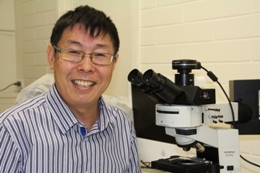29 April 2015
 Adelaide and Chinese scientists have made a ground breaking molecular discovery in their work to find a cure for Alzheimer’s Disease.
Adelaide and Chinese scientists have made a ground breaking molecular discovery in their work to find a cure for Alzheimer’s Disease.
Published today in the prestigious international journal Molecular Psychiatry, the research is a joint collaboration between scientific groups led by Professor Xin-Fu Zhou at the University of South Australia and Professor Yanjiang Wang at China’s Third Military Medical University.
Prof Xin-Fu Zhou, who is UniSA’s Research Chair in Neurosciences, says the discovery of one of the mechanisms of Alzheimer’s Disease opens the door to further research into potential treatments.
“Currently, only a few drugs help with the symptoms of Alzheimer’s Disease and there is no cure,” he says.
Alzheimer’s Disease accounts for nearly 70 per cent of all dementia cases. Dementia affects a staggering 44 million people around the world, with more than 342,000 Australians living with dementia. Without a medical breakthrough, the number of Australians with dementia is expected to be almost 900,000 by 2050
“Alzheimer’s Disease is one of the most devastating diseases currently facing society,” Prof Zhou says.
“Its effects are devastating on the individual, their carer and family, and the economic burden on health and aged care systems will only increase without urgent further research.”
Prof Zhou and Prof Wang’s Molecular Psychiatry article is titled p75 ectodomain is a physiological neuroprotective molecule against amyloid-beta toxicity in the brain of Alzheimer’s Disease.
“Alzheimer’s Disease is a kind of metabolic disease which produces too much toxic metabolic product and causes breakdown of nerve connectivity,” Prof Zhou says.
“Neurodegenerative signals such as amyloid-beta (Aβ) and the precursors of neurotrophins, outbalance neurotrophic signals, causing synaptic dysfunction and neurodegeneration.
“Fortunately, people normally have mechanisms which produce sufficient amounts of nerve protective factors which can prevent the damage of toxic metabolites to the brain.
“The neurotrophin receptor p75 (p75NTR) is a receptor of Aβ and precursors of neutrophins and mediates the toxicity of the neurodegenerative signals. However, the shedding of its extracellular domain (P75ECD) of p75 from the cell surface is a neuroprotective event and physiologically regulated.”
Profs Zhou and Wang discovered that in Alzheimer’s Disease, the full length p75 which causes nerve damage is increased but the level of neuroprotective p75ECD in the brain and cerebral spinal fluid is reduced to the abnormality in the process of p75ECD shedding.
They showed that restoration of p75ECD to the normal level by brain delivery of the gene encoding human p75ECD before or after Aβ deposition in the brains of mice reversed the behavioural deficits and Alzheimer’s Disease-type pathologies, such as Aβ deposit, apoptotic (cell death) events, neuroinflammation, Tau phosphorylation, and the loss of dendritic spine, neuronal structures and synaptic proteins. They also showed p75ECD can reduce amyloidogenesis by suppressing β-secretase expression and activities.
“Our data demonstrates that p75ECD is a physiologically neuroprotective molecule against Aβ toxicity and would be a novel therapeutic target and biomarker for Alzheimer’s Disease,” Prof Zhou says.
“Further studies are required to validate p75ECD as a drug candidate and diagnostic marker in preclinical and clinical trials.”
Contact for interview: Prof Xin-Fu Zhou email xin-fu.zhou@unisa.edu.au
Media contact: Kelly Stone office (08) 8302 0963 mobile 0417 861 832 email Kelly.stone@unisa.edu.au




